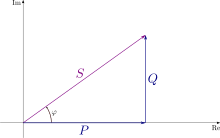Volt-ampere reactive
| It has been suggested that this media object be renamed to File:Reactive Power or a more suitable name for the following reason: Volt-ampere reactive is an industrial unit used to measure reactive power. Since the article is describing reactive power as a whole; reactive power will be a better title For further information about when to rename, see Wikipedia:File names. This request will be dealt with by an administrator or file mover. Warning: the {{Rename media}} template is not meant to be used outside the File: namespace. Use {{Requested move}} on the talk page of the page that you believe should be moved instead. |
In electric power transmission and distribution, volt-ampere reactive (var) is a unit by which reactive power is expressed in an AC electric power system. Reactive power exists in an AC circuit when the current and voltage are not in phase. The correct symbol is var and not Var, VAr, or VAR,[1] but all three terms are widely used, and VAR is widely used throughout the power industry infrastructure. The term var was proposed by the Romanian electrical engineer Constantin Budeanu and introduced in 1930 by the IEC in Stockholm, which has adopted it as the unit for reactive power.
Special instruments called varmeters are available to measure the reactive power in a circuit.[2]
Vars may be considered as either the imaginary part of apparent power, or the power flowing into a reactive load, where voltage and current are specified in volts and amperes. The two definitions are equivalent.
The unit "var" does not follow the recommended practice of the International System of Units, because the quantity the unit var represents is power, and SI practice is not to include information about the type of power being measured in the unit name.[3]
Reactive power

A sinusoidally alternating voltage applied to a purely resistive load results in an alternating current that is fully in phase with the voltage. However, in many applications it is common for there to be a reactive component to the system, that is, the system possesses capacitance, inductance, or both. These electrical properties cause the current to change phase with respect to the voltage: capacitance tending the current to lead the voltage in phase, and inductance to lag it.
For sinusoid currents and voltages at the same frequency, reactive power in vars is the product of the RMS voltage and current, or the apparent power, multiplied by the sine of (phase angle between the voltage and the current). The reactive power (measured in units of volt-amperes reactive or var) is given by:
where is the phase angle between the current and voltage. refers to the maximum value of the instantaneous power absorbed by the reactive component of the load.
Only effective power, the actual power delivered to or consumed by the load, is expressed in watts. The imaginary part is properly expressed in volt-amperes reactive.
Physical significance of reactive power
In power transmission, since most loads are inductive in nature, there is always reactive power present in the system. Since reactive power does not do any real work, the extra current supplied to provide the reactive power means greater line losses and high thermal limits for equipment too which translate to higher cost to operators which is why industries are charged if they have a low power factor.
Managing the reactive power flow in addition to real power flow becomes a very important task for operators to ensure voltage stability throughout the system. In general terms, decreasing reactive power causing voltage to fall while increasing it causing voltage to rise. A voltage collapse occurs when the system serves a higher load than the voltage can support.[2]
See also
Notes and references
- ^ Council Directive on units of measurements 80/181/EEC: "Special names for the unit of power: the name volt–ampere (symbol ‘VA’) when it is used to express the apparent power of alternating electric current, and var (symbol ‘var’) when it is used to express reactive electric power." Chapter 1.2.3., p. 6
- ^ a b Wildi, Theodore (2002). Electrical Machines, Drives and Power Systems. Pearson. p. 137. ISBN 978-0130930835.
- ^ SI Brochure, 8th ed.: "Just as the quantity symbol should not imply any particular choice of unit, the unit symbol should not be used to provide specific information about the quantity [...]" Section 5.3.2.
 This article incorporates public domain material from Federal Standard 1037C. General Services Administration. Archived from the original on 2022-01-22.
This article incorporates public domain material from Federal Standard 1037C. General Services Administration. Archived from the original on 2022-01-22.



